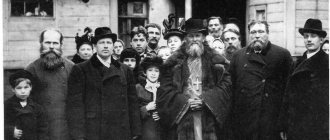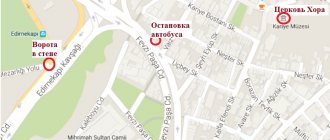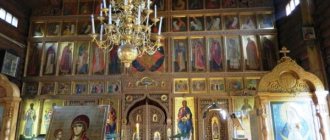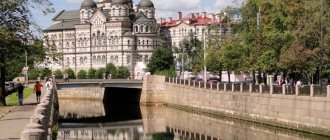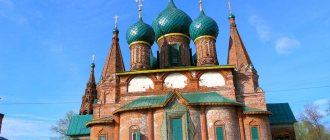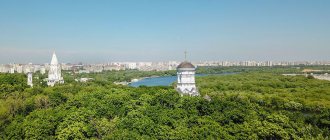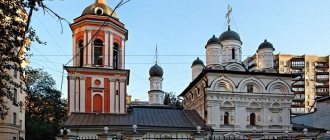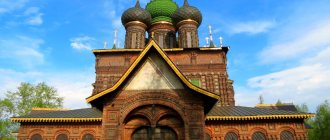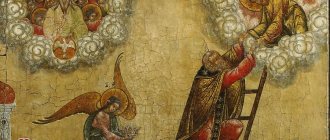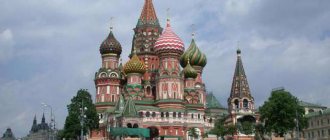| Orthodox church | |
| Church of John of Kronstadt in Golovin | |
| A country | Russia |
| City | Moscow |
| Confession | Orthodoxy |
| Diocese | Moscow city |
| Deanery | Znamensky deanery |
| Date of construction | 2016 |
| Status | Active |
| Website | Official site |
55.846333, 37.50766755°50′46.8″ n. w. 37°30′27.6″ E. d. / 55.846333° n. w. 37.507667° E. d. (G) (O) (I)
Church of John of Kronstadt in Golovin
- an Orthodox church belonging to the Znamensky deanery of the Moscow city diocese of the Russian Orthodox Church. Located in the Golovinsky district of the Northern Administrative District of Moscow. Currently, a temporary temple has been built from prefabricated structures.[1].
Story
The idea of creating a temple appeared in 1990. Its construction was planned to replace St. Andrew's Cathedral in Kronstadt, which was destroyed in 1932. However, there was a catastrophic lack of funds for the construction of the temple, and it was decided to build a small church. The project was entrusted to the development of the architect Ivan Nikolaevich Knyazev.
Construction of the temple began in 1998 after the Orthodox community was created: the Parish of the Church of St. Righteous John of Kronstadt on Kronstadt Square
The laying ceremony for the temple was performed by Archpriest Viktor Golubev. The work was completed in 2002. At the end of 2004, the temple was consecrated - the same archpriest Viktor Golubev performed the sacrament. The name was given at the request of the Orthodox community.
Also in 2004, Archpriest Mikhail Podoley was appointed rector, who still holds this position.
Today there is a Sunday school at the church, catechism courses are held and an Orthodox youth club operates.
Church of St. Venerable Righteous John of Kronstadt
Church of St. Venerable Righteous John of Kronstadt Square of John of Kronstadt, building 2. Church of St. John of Kronstadt modern architecture, topped with a blue dome, is located at the intersection of Stachek Avenue and Leninsky Avenue. Here in the 18th century there was one of the dachas on the Peterhof road. Her owners alternately were F.M., A.M., F.A. Apraksin, G.N. Teplov, N.M. Golitsyn, merchant G.G. Baherakht. In the 30s In the 19th century, the dacha was owned by the German colonist Yegor Yakovlevich Schaefer, and then by his heirs. A small church with a characteristic blue dome was built according to the design of the architect I.N. Knyazev in the neo-Russian style, one of the branches of the Art Nouveau style. On December 21, 2004, the church was consecrated by the dean of the Nevsky district, Archpriest Viktor Golubev. At the request of the local community, the temple was named in the name of the holy righteous John of Kronstadt. The temple is small in size; on the outer wall of the altar there is an icon with the face of John of Kronstadt. Near the temple there was a chapel with a baptismal sanctuary in the name of St. the royal passion-bearer Tsarevich Alexei. At the initiative of the parish, on November 30, 1999, the name of St. Righteous John of Kronstadt was also appropriated to the nameless square at the intersection of Leninsky Prospekt and Stachek Ave. Father John played a big role in the spiritual life of pre-revolutionary St. Petersburg. In the world he bore the name Sergiev Ivan Ilyich, was born on October 19, 1829, and left this world on December 20, 1908. The priest owes his name to the fact that he became famous when he served as archpriest of St. Andrew's Cathedral in Kronstadt. Canonized by the Russian Orthodox Church in 1990. The memory of Righteous John of Kronstadt is celebrated on December 20, or January 2 according to the new style. On the site adjacent to the church it is planned to build a second temple - in the name of the Royal Martyrs, as well as an Orthodox cultural and educational center and an almshouse. The project of the temple complex of the Holy Venerable and Righteous John of Kronstadt was completed in the architectural studio “Evgeniy Gerasimov and Partners”. Head of the team of authors E.L. Gerasimov, chief architect of the project S.D. Merkusheva, architects - K.V. Smirnov, S.I. Burdonskaya and M.V. Chentsov, chief designer M.Ya. Reznichenko. Construction dates have already been postponed several times due to lack of funds, since the main source of funding is donations. The church has a Sunday school for children - junior and senior groups, and catechist courses. There is a library of Orthodox literature. The temple provides care for the “Little Mother” shelter for minor mothers and a boarding home in Peterhof for children with mental disabilities. The newly built church belongs to the St. Petersburg diocese of the Russian Orthodox Church. The rector of the temple is Archpriest Mikhail Podoley. In front of the church is the Obelisk of Glory, opened on the initiative of the administration of the Kirov region on May 5, 1995, to mark the 50th anniversary of the Victory over Nazi Germany. The monument is dedicated to the heroes of the Narva outpost who died during the Great Patriotic War. The obelisk was developed by a group of specialists from Spetsmash JSC, under the guidance of designer Yu. A. Kudryakov and designer D. D. Blokhin, and is made of metal. The construction cost 148 million rubles at 1995 prices. Several enterprises took part in its production - JSC Spetsmash, Severnaya Verf and House-Building Plant No. 3. The height of the obelisk is 7 meters. The inscription on it reads: “TO THE HEROES OF THE NARVA OUTPUT WHO STANDED IN THE BATTLES FOR VICTORY AND WITH IT STEP INTO IMMORTALITY.”
Architecture
The Church of the Holy Righteous John of Kronstadt is made in the neo-Russian style - this is one of the branches of the Art Nouveau style of the early twentieth century. There are practically no other buildings in this style left in the city.
Interior decoration
White walls with paintings, a painted vault of heavenly color, a huge chandelier in the center and a wooden carved iconostasis are what characterize the temple. Due to the abundance of windows in the shape of a soft triangle, a large amount of daylight enters inside, and the inside of the temple is very bright. True, the premises are small, and, unfortunately, the temple often cannot accommodate everyone at the same time.
Exterior decoration
The small temple, which looks more like a chapel, has an elongated irregular shape. White stone walls and bright blue domes and roofs attract attention from afar. The abundance of soft triangles in the interior makes the building very unusual. Windows of the same shape with small glazing and wooden overhanging cornices are a distinctive feature of the Church of St. John of Kronstadt.
According to architectural historian M. N. Mikishatyev, the building is very reminiscent of the work of A. Shchuseyev
[edit] Notes
- Church of John of Kronstadt in Golovino - Registration card. temples.ru
- For the first time in 80 years, residents of Golovino will be able to come to their church for Epiphany water / Financial and Economic Administration of the Russian Orthodox Church (Moscow Patriarchate). fedmp.ru.
- Municipal district Golovinsky. Festive event dedicated to Victory Day!. nashe-golovino.ru.
- Liturgical life began in the new Church of St. John of Kronstadt in Golovino (large photo report). 200hramov.ru.
- ↑ 5.05.1 Church of St. right John of Kronstadt in Golovin (temporary) / Northern Vicariate / Moscow Diocese / Russian Orthodox Church (Moscow Patriarchate). severvik.ru.
Where is
Address
Kronstadt Square, 2
Metro
- Avenue of Veterans
- Leninsky Prospekt
- "Avtovo"
How to get there
- If you are interested in how to get there on foot from the Prospekt Veteranov metro station, then you first need to go to Dachny Prospekt, cross the road and move left. Walk along the avenue all the way to Kronstadt Square, there you turn right, and the temple will be in front of you. From the Prospekt Veteranov metro stop, you can get to the Leni Golikova stop by minibus No. 650A or by bus No. 486 and walk about 900 meters.
- If you are coming from the Leninsky Prospekt metro station, you need to go out onto Leninsky Prospekt itself, cross the road, turn left and walk all the way to Kronstadt Square. Turn right there and you'll end up next to the temple. You can also get from the Leninsky Prospekt Metro stop to the Kronstadt Square stop by bus No. 26, 87, 142, by trolleybus No. 32, 35, 45 or by minibus No. 35, 43, 45, 87, 103, 142, 226, 242, 339, 420 to the Kronstadt Square stop and walk about 100 meters.
- If you are moving from the Avtovo metro station, you need to go out to Avtovskaya Street, walk to Kronstadt Street and walk along it all the time. Then cross Marshal Kazakov Street, turn left, walk to Stachek Avenue and move along it to Kronstadt Square. Cross the road there and you will find yourself at the temple. From the Avtovo Metro stop, you can get to the Solomakhinsky Proezd stop by minibus No. 401A or tram No. 36, 41, 52 and walk just under 400 meters. You can also get there from the Prospekt Stachek stop by minibus No. 655.
Wonderworker John of Kronstadt: when and why do they pray to the saint
One of Father John’s contemporaries recorded the following story in his diaries. It was at the St. Petersburg station, the end of the 19th century. That day, a certain drunkard, a degenerate man, was hanging around the station area. He was hanging around without anything to do and without a goal, until his attention was attracted by a huge crowd: they were meeting someone. Either out of curiosity, or expecting to beg for some money to “get drunk”, the drunkard decided to join the venerable gathering. From conversations, he realized that everyone was waiting for the arrival of some “Father John” - a rare occurrence. The priest, maybe he’ll give you alms? To the displeasure of those greeting him, the drinker began to actively squeeze closer to the approaching train and even to the opening door of the carriage. He squeezed through the hissing and indignation of a decent, decent public, and at that time a short, lean priest with surprisingly deep blue eyes came out of the carriage. And then, as witnesses of the scene say, Father John, as if seeing his dearest person, “embraced” our drunkard with such warmth and love that the indignant ones became silent. And then he himself approached the drunkard, said something quietly and affectionately to him, and then blessed him. Soon the drunkard was noticed in the church where Father John served, in St. Andrew's Church in Kronstadt: he found it himself, he came himself. And, having come to Father John, he remained like that - in another, new, sober life. And this is not the only story of the transformation of a person under the influence of Father John of Kronstadt, which is why they pray to the saint for those who die from drunkenness, drug addiction, for people who have degenerated, for those who have long given up on themselves.
But not only. Holy Righteous John of Kronstadt is a “quick helper and merciful intercessor” (that is, appearing and interceding for us before God) in case of illness, everyday problems, in need and desperate situation.
A miracle worker, a prophet, a healer of diseases, even in absentia - by letter or sent by telegram, a donor through whose hands from 150 thousand to 1,000,000 rubles a year passed, Righteous John of Kronstadt is one of the most famous Russian saints. Moreover, when we say “Russian saint” in relation to Father John of Kronstadt, we must remember that his help to people - both through prayer and money - went beyond the national. Father John helped the Orthodox, Muslims, and Jews.
1. Holy and Righteous John of Kronstadt (1829-1908), lifetime photo.
Holy and Righteous John of Kronstadt (1829-1908), lifetime photo.
“God has neither Greeks nor Jews. I don't have my own money. They donate to me, and I donate. And often I don’t even know who and where sent me this or that amount. That’s why I donate to where there is a need, where this money will be useful,” said the priest.
This also concerned cases of healing of diseases - the saint saved “a Russian, a Pole, a German, a Tatar and a Jew.” Is it any wonder that the name of the priest from Kronstadt, even during his lifetime, thundered throughout the Russian Empire, causing, on the one hand, veneration, even painful worship, and on the other, ardent hatred, envy, mockery, and caustic ridicule.
We were lucky, the years of the saint’s life—from 1829 to 1908—came at a time when humanity learned to keep personal diaries, so we can, no, not judge, figure out what kind of phenomenon this is: the righteous saint John of Kronstadt.
Ioann Sergiev was born into a poor family of a rural sexton. There were many priests in the saint’s family, and from childhood he himself clearly gravitated toward God. When the boy turned ten, his parents, having difficulty raising the necessary amount, enrolled him in the Arkhangelsk parish school. At first, studying was difficult for young John, but, according to the recollections of the saint himself, one day, after fervent prayer, it was as if scales had fallen from his eyes: book sciences became easy and understandable to him. Then there was the seminary and the St. Petersburg Theological Academy, where the brilliant seminarian Ivan Sergiev entered the government account.
Next are his youthful dreams about monasticism, about how he would preach Christianity in China. However, seeing that the residents of the capital “know Christ no more than the savages of some Patagonia,” candidate of theology John Ilyich Sergiev, taking as his wife the daughter of the rector of St. Andrew’s Cathedral in Kronstadt, began his ministry in this temple.
A moment that is difficult for modern readers to understand: having entered into marriage, Ivan Ilyich persuaded his wife to remain virgins - the saint wanted to devote himself entirely to serving God and people.
Kronstadt at that time was a place of administrative expulsion from the capital of asocial individuals: tramps, those who do not remember kinship, prostitutes, and beggars. Like the families of the port laborers, all these people huddled in shacks. Drunkenness, fights, robbery, begging, prostitution, hopeless poverty and disease - that was the life of the inhabitants of the port town. This is where the saint begins his sermon. A sermon is not only in the literal sense - as a speech given after a service. Preaching Christianity as a matter of love and care for the most rejected. Father John not only distributes all his earnings to those in need, he is ready to give away his only boots and clothes, he consoles the desperate, sits with the sick, takes care of children, and later the priest will build the famous House of Industriousness. It will be built with money raised by the people.
There will be workshops, a canteen, a school, shelters, and a library. Of course, at first the saint was not understood, the boundlessness of his service was not accepted - both by those whom he helped and by the clergy, who were not ready for such selflessness.
2. In the House of Diligence, founded by Fr. John, the poor could earn money for food and lodging. Sewing workshop in the House of Diligence (Kronstadt). End of the 19th century
Sewing workshop in the House of Diligence (Kronstadt). End of the 19th century
One day, Father John was summoned to St. Petersburg, to see Pobedonostsev, the chief prosecutor of the Holy Synod. “You, father, hit a high note,” Pobedonostsev notes, “Many people before you hit this note, but then they had to falsify it.” “Don’t worry,” he hears in response, “I won’t fake it, I’ll deliver what I’ve taken to the end.”
It is easy to dream of serving God and people as the Gospel requires, as Christ expects of us, but not everyone can carry this feat of service through their entire life. Desire alone is not enough; you need daily appeal to God’s help, you need the help of God’s grace. Father John prays from early morning, then serves the Divine Liturgy, every single day, then visits those in need, then again prayer, reading the Bible, and a short nap. And so for fifty-three years, not paying attention to the blasphemy and hatred of those who do not understand, or to the growing glory, surpassing all conceivable limits. Not for illness. Prayer, constant turning to God - this is the source of his miracles, the reason for his gifts - healing, insight, prophecy.
In the prayer to the holy righteous John of Kronstadt himself, he is called: “the great wonderworker and saint of God, God-bearing Father John.” In the Church, holy ascetics are called God-bearers, who throughout their lives embody the Gospel commandments of love for God and their neighbors.
3. Holy Righteous John of Kronstadt. Icon painting workshop of the Holy Trinity Church in Kursk.
Holy Righteous John of Kronstadt. Photo: Icon painting workshop of the Holy Trinity Church in Kursk
“All the strength in Father John of Kronstadt lay in his true, living, active faith in Christ the Savior and His teaching, in complete penetration of this teaching, which became his native and eternal element, true knowledge, according to the word of the Apostle, and not simple and cold knowledge. He believed beyond any doubt, he, one might say, strengthened his faith; he spoke and thought about things related to faith not as handed down, but as if he personally experienced and saw everything. When he spoke about something spiritual, it was felt that he was speaking as if he were an eyewitness,” said Bishop Arseny (Zhadanovsky), a contemporary of the saint. “Father John was so strengthened in the faith that he was completely imbued with spiritual contemplation and with the apostle he could say: it is no longer I who live, but Christ lives in me.” And as eyewitnesses said, “the sky was reflected in his eyes, compassion for people was in his face, and the desire to help everyone was in his address.” We pray to the saint in illness, in need, when we lose a job, when we find ourselves in a desperate situation. And also when children get out of hand, or they simply find it difficult to study.
